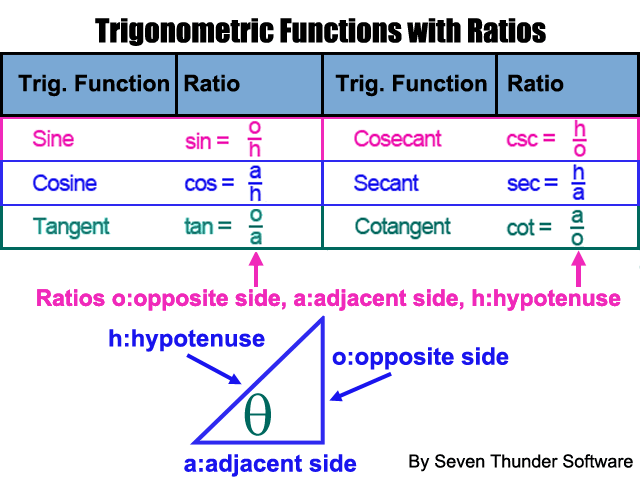Co-Functions
Chapter 1.4
A Worthwile Discovery
Did you notice while completing exercises related to the previous section, that sin 100 was the same as cos 800? Sin 250 = cos 650. Also cos 580 = sin 320 and sin 580 = cos 320.
Complementary Angles
100 and 800 are complementary angles. So are 250 with 650 and 580 with 320.
We shall, therefore, say that when we have complementary angles, the sine of one angle is always equal to the cosine of the other angle. Does this statement explain why sin 450 equals cos 450? Prove sin 450 equals cos 450 in another way.
Theorem
When two angles are complementary, the sine of one angle equals the cosine of the other.
Additional Ratios
In addition to the sine, cosine, and tangent of an angle, there are three other useful ratios.

Cotangent
The cotangent of an angle is the ratio of the adjacent leg to the opposite leg. For example, from the diagram above:
adjacent leg a
cot B = ------------ = -
opposite leg b
What is cot A?
Secant
The secant (abbreviated sec) of an angle is the ratio of the hypotenuse to the adjacent leg. For example, from the diagram above:
hypotenuse c
sec B = ------------ = -
adjacent leg a
What is sec A?
Cosecant
The cosecant (abbreviated csc) of an angle is the ratio of the hypotenuse to the opposite leg. For example, from the diagram above:
hypotenuse c
csc B = ------------ = -
opposite leg b
What is csc A?
Theorem
When two angles are complementary, the tangent of one angle equals the cotangent of the other; the secant of one angle equals the cosecant of the other.
NOTE - These theorems explain why it's not necessary to work out functions for angles between 450 and 900 if the functions between 00 and 450 have already been obtained.

Pages 9-11
Trigonometry Help
Buttons link to trigonometry textbook sections.
Trigonometry helps programmers, engineers, scientists, teachers, and students. Trigonometry provides a foundation with mathematics required for game programming, science, technology, engineering, and math (STEM).
Trigonometry tutorials are modified from the public domain book titled,
Plane and Spherical Trigonometry
,
by Hayes and Leventhal.
Globe Book Company, New York, N. Y.
Love learning math with tutorials and games from Seven Thunders.



